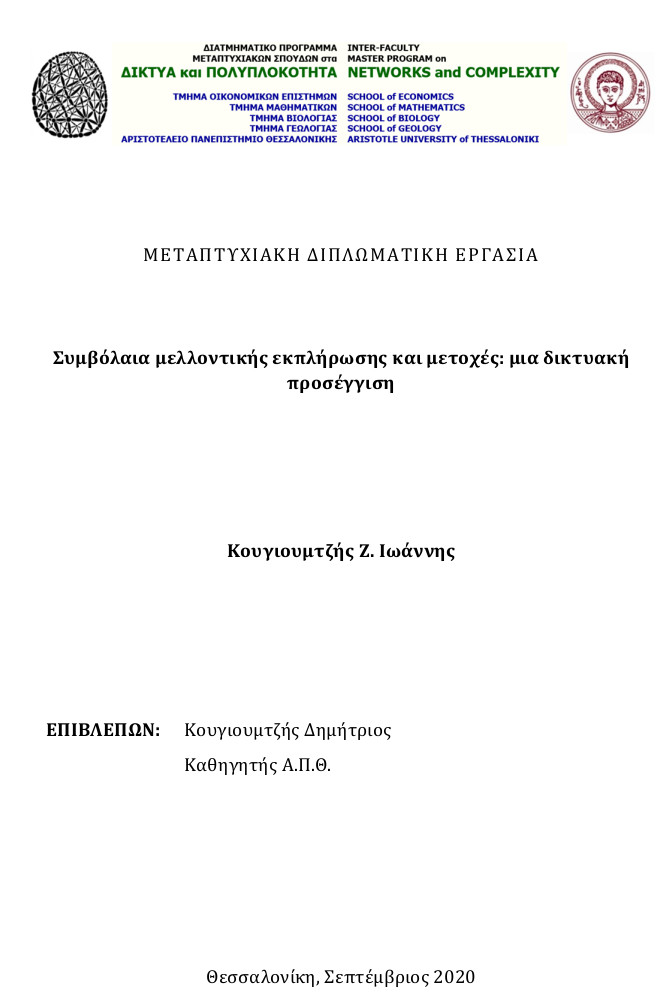
Συμβόλαια μελλοντικής εκπλήρωσης και μετοχές: μια δικτυακή προσέγγιση = Commodity futures and equities: a network approach.
Περίληψη
Στην εργασία αναλύεται ένα σύστημα που περιλαμβάνει μετοχές και συμβόλαια μελλοντικής εκπλήρωσης με υποκείμενο μέσο εμπορεύματα. Στόχος είναι να βρεθούν οι άμεσες σχέσεις αιτιότητας που υπάρχουν, αναλύοντας τις χρονοσειρές 58 μετοχών του δείκτη S&P500 με τη μεγαλύτερη κεφαλαιοποίηση κατά τομέα και 24 συμβολαίων μελλοντικής εκπλήρωσης που διαπραγματεύονται στα ανταλλακτήρια της Νέας Υόρκης και του Σικάγο. Για την κατασκευή των δικτύων με συνδέσεις που αντιστοιχούν σε σχέσεις άμεσης αιτιότητας χρησιμοποιήθηκαν τα μέτρα: (α) Δείκτης δεσμευμένης αιτιότητας κατά Granger (CGCI), που είναι γραμμικό μέτρο άμεσης αιτιότητας, (β) περιορισμένος δείκτης δεσμευμένης αιτιότητας κατά Granger (RCGCI), που είναι μέτρο με μείωση της διάστασης του μοντέλου στο (α) και (γ) μερική αμοιβαία πληροφορία από μικτή εμβύθιση (PMIME), που είναι μέτρο πληροφορίας με μείωση διάστασης. Η πρώτη ανάλυση έγινε σε κυλιόμενα χρονικά παράθυρα 18 μηνών και η δεύτερη σε παράθυρα 4 μηνών, για να μελετηθούν δομικές αλλαγές του χρηματοοικονομικού συστήματος σε διαφορετικές χρονικές κλίμακες. Για την ανάλυση των δικτύων και για την εξαγωγή συμπερασμάτων χρησιμοποιήθηκαν περιγραφικά μέτρα δικτύων και μέτρα κεντρικότητας, τόσο σε επίπεδο δικτύου όσο και σε επίπεδο κόμβων. Τα αποτελέσματα της ανάλυσης δείχνουν πως υπάρχουν δομικές διαφορές στα δίκτυα όταν υπάρχει κάποια οικονομική αναταραχή, ανεξάρτητα από το μέτρο που χρησιμοποιήθηκε για την κατασκευή τους. Τέλος, φαίνεται πως το σύστημα που περιλαμβάνει και τα δύο χρηματοοικονομικά μέσα παρουσιάζει ερευνητικό ενδιαφέρον, καθώς πολλές από τις σχέσεις αιτιότητας είναι μεταξύ χρηματοοικονομικών μέσων των διαφορετικών κατηγοριών.
In this thesis, a system that includes both equities and commodity futures is being examined. The goal is to find the direct causal relationships, analyzing the time series of 58 stocks which are components of the S&P500 index with the largest capitalization by sector, and 24 commodity futures traded at the New York and Chicago exchanges. In order to construct networks with links corresponding to direct causality relationships, the following measures were used: (a) Conditional Granger Causality Index (CGCI), which is a linear measure of direct causality, (b) Restricted Conditional Granger Causality Index (RCGCI), which is a measure that applies dimension reduction in model at (a), and (c) Partial Mutual Information from Mixed Embedding (PMIME), which is a measure of information applying dimension reduction. At the first phase, analysis was performed in 18-month rolling time windows and at the second phase in 4-month windows, in order to note structural changes of the financial system in different time scales. Descriptive network measures and centrality measures, both local and global, were used to analyze networks and to draw conclusions. The results of the analysis show that there are structural changes at networks when there is some financial turmoil, regardless of the measure used for their construction. Finally, it seems that the system that includes both financial instruments is of research interest, as many of the causal relationships are between instruments of different categories.
In this thesis, a system that includes both equities and commodity futures is being examined. The goal is to find the direct causal relationships, analyzing the time series of 58 stocks which are components of the S&P500 index with the largest capitalization by sector, and 24 commodity futures traded at the New York and Chicago exchanges. In order to construct networks with links corresponding to direct causality relationships, the following measures were used: (a) Conditional Granger Causality Index (CGCI), which is a linear measure of direct causality, (b) Restricted Conditional Granger Causality Index (RCGCI), which is a measure that applies dimension reduction in model at (a), and (c) Partial Mutual Information from Mixed Embedding (PMIME), which is a measure of information applying dimension reduction. At the first phase, analysis was performed in 18-month rolling time windows and at the second phase in 4-month windows, in order to note structural changes of the financial system in different time scales. Descriptive network measures and centrality measures, both local and global, were used to analyze networks and to draw conclusions. The results of the analysis show that there are structural changes at networks when there is some financial turmoil, regardless of the measure used for their construction. Finally, it seems that the system that includes both financial instruments is of research interest, as many of the causal relationships are between instruments of different categories.
Πλήρες Κείμενο:
PDFΕισερχόμενη Αναφορά
- Δεν υπάρχουν προς το παρόν εισερχόμενες αναφορές.
